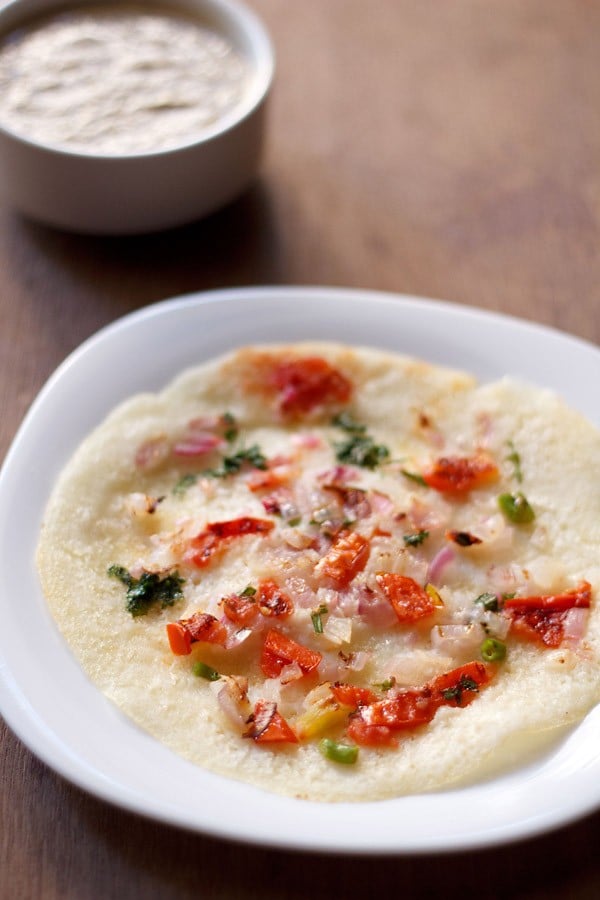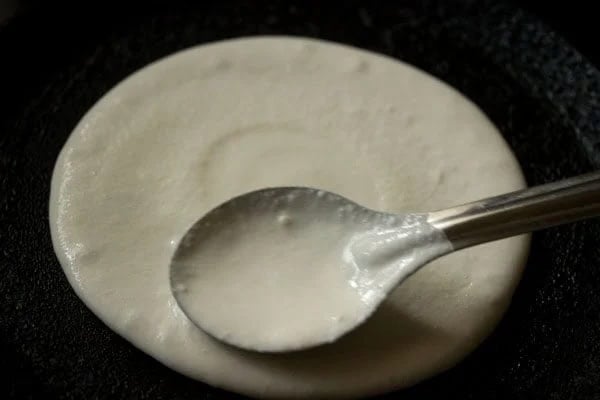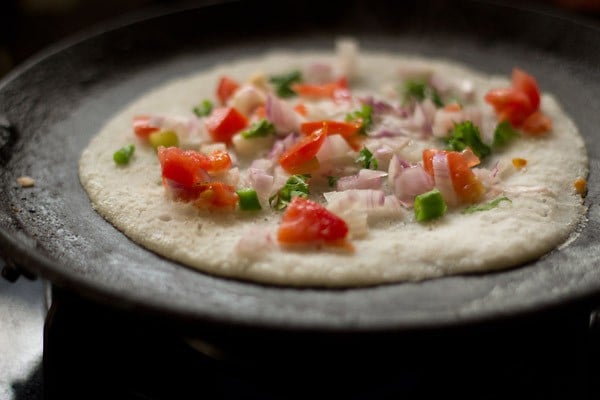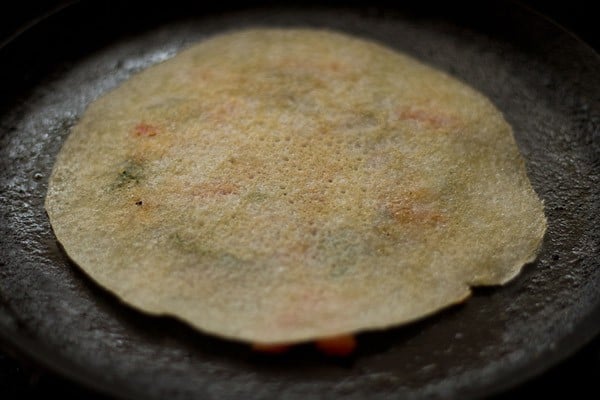Tomato Uttapam | Onion Tomato Uttapam
A very comforting and satisfying, not to forget, delicious dish too is that of an uttapam. These are just your good ol’ savory pancakes with some toppings and are a popular breakfast choice from the cuisine of South India. On this post, I have shared a personal favorite recipe, Tomato Uttapam. Also referred to as Onion Tomato Uttapam, these are also nutritious as well as easy to make. Gluten-free and vegan recipe too.
About Tomato Uttapam
Got some leftover dosa batter and don’t really want to eat any more dosas? Here’s what you can actually make with it. This recipe of Tomato Uttapam is one of the simplest ways to use up your leftover batter and turn it into something equally healthy and tasty.
Even I usually make an Uttapam at home with the leftover Idli Batter or Dosa Batter. Speaking of uttapams reminds me of my mother who always prefers them over dosas.

Instead of regular dosas she likes to make uttapams for herself. Since both can be from the same batter, so you have the option to choose.
With this Onion Tomato Uttapam recipe that I have shared here, you are able to just bring in a customization to the regular recipe.
In addition to the dosa batter, finely chopped tomatoes & onions, all you require for this Tomato Uttapam recipe is some finely chopped coriander leaves, oil to cook and some ground spice mix. The options for this are either Sambar Masala or Idli Podi or even pav bhaji masala.
Personally, I like both uttapam and dosa. The main difference between them and dosa is that they are thicker than dosa and more like a Pancake.
Additionally due to the thickness, on occasions if you don’t cook them properly, the inner portion can remain slightly undercooked. So it is essential to cook them completely on a medium-low to medium heat.
Just like this Onion Tomato Uttapam, there are different varieties of uttapams that you can definitely try. Some of them are:
Like dosa, you can pair this Tomato Uttapam too with a tasty Coconut Chutney and Sambar, and turn it into a lovely breakfast, brunch or even a lunch meal.
How to make Tomato Uttapam
1. First, make dosa batter. In this post of dosa, I have explained how to make homemade Dosa Batter. You can also use leftover idli or dosa batter.
Mix the chopped onions, tomatoes, green chili and coriander leaves together in a bowl.
Heat a cast iron skillet or griddle or non-stick tawa. If using a non-stick tawa, then no need to spread oil on it. For a griddle, you can spread the oil.
Take 1 ladle of uttapam batter and spread it in a circle on the tawa similar to the way you would make a dosa. Only the quantity of batter will be more than what you would normally use for a dosa. The uttapam should be slightly thick.

2. Top the uttapam with onion, tomatoes and chili mixture. Sprinkle Pav Bhaji Masala or sambar masala or idli podi (dry chutney powder for idli and dosa) and a pinch of salt on top of the vegetables and uttapam.
Press the veggies on the uncooked batter, so that they stick onto it. Drizzle some oil on the sides and top.

3. Once the base is cooked well and golden, turn and spread some oil on the cooked side.
The onion-tomato side is getting cooked now. Flip the uttapam when this side also gets cooked and onions, tomatoes are light browned or golden.

4. Flip again, if you see the first side is not cooked or browned.
When it is crisp and cooked on both sides, serve the Onion Tomato Uttapam hot with sambar and coconut chutney.
You can also serve it with chutney or simple sweetened or plain curd. Serve them hot to have the best taste.
Repeat making the Tomato Uttapam with in batches with the remaining batter.

Expert Tips
- Batter consistency: Ensure that the batter for uttapam is of the right consistency, that is, neither too thick nor too thin. It should be pourable but not runny.
- Preparation of toppings: Finely chop onions and tomatoes for the topping. Some chopped green chilies or coriander leaves can be added too, to enhance the flavor.
- Preheating the tawa: Heat the tawa or skillet well before pouring the batter. A hot tawa ensures that there’s even cooking of the uttapam and it turns a nice golden one.
- Greasing the tawa: Lightly grease the tawa with oil before pouring the batter. This prevents sticking and helps in getting a crisp texture.
- Variations to this recipe: You can also add grated cheese, chopped capsicum, or other vegetables of your choice to create different variations of uttapam.
Step by Step Photo Guide Above

Ingredients
- 2.5 to 3 cups Dosa Batter
- ½ to ¾ cup onions – finely chopped
- ½ to ¾ cup tomatoes – finely chopped
- 1 or 2 green chilies – finely chopped
- 1 to 2 tablespoon coriander leaves – finely chopped (cilantro), optional
- oil – add as required
- Sambar Powder or pav bhaji masala or idli podi, add as required, optional
Instructions
- First make dosa batter. You can also use leftover dosa batter.
- Mix the chopped onions, tomatoes, green chili, coriander together in a bowl.
- Heat a griddle or non-stick tava or griddle. Take 1 ladle of batter and spread it in a circle on the tava similar to the way you would make a dosa. Only the quantity of batter will be more than what you would normally use for a dosa. The uttapam should be thick.
- Top the uttapam with the onion, tomatoes and chili mixture. With a spatula press the topping ingredients on the batter, so that they stick on the batter.
- Sprinkle a bit of pav bhaji masala or sambar masala or idli podi and salt on top of the veggies and uttapam.
- Sprinkle some oil on the sides and top of the uttapam.
- With the spatula, flip when the base is cooked and golden. Spread some oil on the cooked side.
- The onion tomato side will be getting cooked. Flip when this side also gets cooked and the veggies are slightly caramelized.
- Flip again if you see the first side is not cooked or browned.
- When the Tomato Uttapam is crisp and cooked on both sides, then serve it hot with sambar and coconut chutney. You could also serve them with curd chutney or simple sweetened or plain curd.
- Serve them hot to have the best taste.
Notes
- Cook on a medium-low to medium heat. They take a little more time to cook than dosa, as they are thick.
- Ensure to cook the uttapam well. The batter must be cooked properly with a soft, fluffy texture. There should no raw batter or undercooked batter in the center of the uttapam or at the sides. To ensure a thoroughly cooked Tomato Uttapam, cook on a medium-low to medium heat and avoid cooking on a high heat.
- You can also make these uttapams in butter or ghee if you like.
This Onion Tomato Uttapam from the archives was first published on May 2010. It has been updated and republished on June 2024.

Can I add more veggies in this recipe?
Yes, you can. Choose veggies like grated carrots, beets, finely chopped or thinly spiced capsicum, cabbage, spring onions.